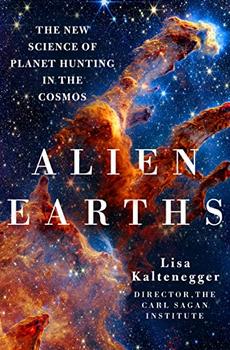Summary | Excerpt | Reviews | Beyond the Book | Readalikes | Genres & Themes | Author Bio

The New Science of Planet Hunting in the Cosmos
by Lisa Kaltenegger
This view of ancient galaxies fills me with wonder—and hope. There are billions of stars in this image, ancient echoes of other possible worlds. In this tiny corner of our cosmos, planets could have been formed countless times, and yet our now and their now do not intersect because of the vastness of space between us. While some stars—like those in the deep-field image on my computer screen—are lost in time to us, a myriad of closer stars remain—with intriguing worlds circling them. And now we can explore the closest ones.
In science, by finding new ways of seeing, such as catching the light from dimmer objects in the huge mirror of the JWST, we are able to detect what we could only imagine before. New insights transform our understanding. These images are a touching testament to the cooperative spirit of humanity: it took thousands of people from all corners of the world to make that vision a reality.
Among the first images released, one revealed a detailed view of the light from a scorching, puffy giant planet, WASP-96b, shrouded by layers of clouds, haze, and steam. It blasts around its star twice a week. While devoid of life, the JWST image proved that the space telescope can explore the atmospheres of other, smaller Earth-sized planets given more time. Places where life could thrive. As a member of one of the scientific teams behind the JWST, I work with a creative group of scientists to explore these new worlds on our cosmic horizon.
Discovering life on another planet would forever revolutionize our entire worldview.
So Where Is Everyone?
Let's assume, for a moment, that the universe is teeming with life. In that case, the obvious question is: Where is everyone? In my introductory astronomy class, "From Black Holes to Undiscovered Worlds," I ask my students to suggest possible explanations for why we have had no credible record of alien visitors to date. I am going to skip all discussion of supposed UFO sightings here, since the subject is full of poor observations and would require a book-length reply like Carl Sagan's thought-provoking The Demon-Haunted World, one of my favorite reads. Among many other insightful points, Sagan asks why alien species that have surpassed us so monumentally in technology that they can travel from star to star would need to abduct a whole person to study. Even a comparatively less advanced species like us humans has developed the technology to take DNA samples from hair or saliva. Wouldn't collecting these samples from unsuspecting humans be a much more effective way to study them than beaming people up into their spaceships one by one? For the record, most of my students' theories involve either doomsday scenarios—alien civilizations have destroyed themselves before they can reach out to find others—or the endless void—we haven't seen anyone else because we are the only life the cosmos ever produced.
This puzzle of absent aliens is not new. Enrico Fermi, the Italian-American physicist and Nobel Prize winner, famously posed the question "Where is everybody?" in a conversation on the possibility of extraterrestrial life in 1950. If technological civilizations are common in the universe, surely some would have developed sufficiently to visit or at least contact us by now? This mystery is known as the Fermi Paradox; the discrepancy between the absence of evidence for advanced extraterrestrial life and the high likelihood that it should exist. Casting a dark shadow over the conversation at the time was the fact that scientists were in the midst of developing nuclear weapons that could wipe out civilization on Earth.
How abundant might intelligent civilizations be within our vast universe? One way of thinking about this was proposed by the American astronomer Frank Drake, a pioneer in the search for extraterrestrial intelligence (SETI), who in the 1960s developed a systematic process to assess SETI's prospects. Searching for what he called "a whisper we can't quite hear," he wove together a number of factors in a framework that is called the Drake Equation. The seven interlinked factors began with well-constrained estimates of the rate of star formation, educated guesses on the likelihood of which ones might have planets circling around them, and the fraction of these capable of nurturing life, before continuing on to wild speculations about the probability of life actually evolving, to the fraction of life-forms that might develop intelligence, and the even smaller percentage that might be capable of interstellar communication. The very last factor of the Drake Equation poses a question that can evoke either boundless enthusiasm or chilling pessimism about our chances to connect with any alien civilization: How long can technological civilizations survive?
Excerpted from Alien Earths by Lisa Kaltenegger. Copyright © 2024 by Lisa Kaltenegger. Excerpted by permission of St. Martin's Press. All rights reserved. No part of this excerpt may be reproduced or reprinted without permission in writing from the publisher.
Your guide toexceptional books
BookBrowse seeks out and recommends the best in contemporary fiction and nonfiction—books that not only engage and entertain but also deepen our understanding of ourselves and the world around us.